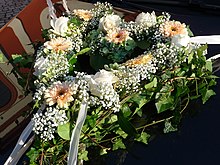Floristry (craft)
Floristry is the artisanal and artistic design of cut flowers and plant decorations . The name is derived from the Latin name Flora , the Roman goddess of flowers and youth.
meaning
Flower making, now known as "floristry", is closely linked to centuries-old traditions. It is common in European culture to decorate mourning halls and graves with wreaths and flower arrangements. Flowers are given away especially for birthdays , baptisms , communions and weddings and events, and the locations of the celebrations are decorated with flowers .
Floral decorations with flowers and arrangements are also common for representative events, for example in business premises and hotels, at conferences and trade fairs as well as in living rooms ; Traditional containers through to "floral art objects" are used here.
education
Florist is a recognized three-year apprenticeship occupation in Germany, Austria and Switzerland , which is trained according to the dual training system in flower shops while attending vocational school at the same time. The trained florist can train to become a master at master schools or technical schools for floristry. A flow of floristry of its own often develops at such training centers. The most important German training centers are in Straubing (Bavaria), Dresden, Gelsenkirchen , Grünberg (Hesse), Hamburg, Stuttgart , Hanover- Ahlem and Weihenstephan .
The floristic training includes in particular the areas of cut flower arrangements ( bouquet , flower arrangements ), wreaths , table decorations or funeral floristry, but also proportions and color theory , style , business calculation and strategies of sales promotion. Basic knowledge of botany and plant protection is also imparted.
Market situation
Florists with their own retail stores (flower shops) are increasingly coming under competitive pressure, since supermarkets , street dealers and franchise companies increasingly offer cut flowers. The strategies with which the professional group wants to secure its traditional market segment include, among other things, technical advice, durability guarantees and a tighter calculation for cut flowers that are offered as individual flowers or so-called bundles . A larger range of ready-made bouquets is also well received by customers.
Name story
The current job title “Florist” was officially introduced in Germany in 1967 and has established itself among the general public. The meaning that existed up to that point was used by Linnaeus in 1725 for his contemporaries, who wrote Floren and, as floristae , dealt with the spatial recording of plants. As a result, famous botanists also called themselves florists . This term is still used in botanical circles.
In addition to this meaning, which was only used until around 1965, “ florists ” and “ flower binders ” also call themselves florists today . So the Duden from 1967 only knows the name as "explorer of flora". From the 17th edition 1973 onwards, “flower ties” are also given.
See also
literature
- Arnd Brandenburg u. a .: Fascination with floristry. Textbook for training. 1st edition. Verlag Europa-Lehrmittel, Haan-Gruiten 2009, ISBN 978-3-8085-6615-2 .
- Karl-Michael Haake: Floristik Lexikon. 1100 technical terms from design, technology, material science. Bloom's, Ratingen 2009, ISBN 978-3-939868-89-7 .
- Tanja Huber: Creative workshop floristry. Basics step by step. Ideas all year round. Christophorus, Stuttgart 2009, ISBN 978-3-419-54130-2 .
- Eleonore Schick: 1x1 creative floristry. Bouquets, arrangements, wreaths & more. With workshop on DVD. Frechverlag, Stuttgart 2009, ISBN 978-3-7724-5067-9 (media combination, with DVD).
- Tanja Huber: Floristry. Decoration trends all year round. 3. Edition. Christophorus published by Herder Verlag, Freiburg im Breisgau 2007, ISBN 978-3-419-53272-0 ( Creativ Compact , No. 53272).
- Jane Durbridge et al. a .: Wedding floristry. Flower arrangements for the bride, groom and flower children. Ulmer, Stuttgart 2003, ISBN 3-8001-3938-3 .
- Andreas Faber: Funeral floristry. Ulmer, Stuttgart 2003, ISBN 3-8001-4177-9 .
- Gerhard Wagenitz : About the word anointing . In: Journal for German Linguistics. Volume 30, Issue 2, 2002, pp. 252-257.
- Ursula Wegener: Bouquets. History, technology, design. Ulmer, Stuttgart 1994, ISBN 3-80016483-3 .
- Karl Löther: Flower arrangements for joy and sorrow: Instructions for using flowers on all kinds of festive occasions . Hachmeister & Thal, Leipzig 1911 ( digitized version ).
Web links
- Professional and branch information floristry for trainers and apprentices of the Austrian Chamber of Commerce
- Florist in Berufenet the Federal Employment Agency
- Fachverband Deutscher Floristen eV
Individual evidence
- ↑ Text of the ordinance on professional training as a florist (Germany)
- ↑ Training regulation for flower makers and dealers (florists) ( page no longer available , search in web archives ) Info: The link was automatically marked as defective. Please check the link according to the instructions and then remove this notice. (PDF; 25 kB) of the Austrian Ministry of Economic Affairs, valid since 1989
- ↑ Page no longer available , search in web archives: Swiss Training Regulations for Florist EFZ valid since 2007
- ↑ New version of the regulatory means while at the same time changing the previous job title of florist by the decision of the BMWi from 11 December 1967 - II B 5 - 46 50 26-13 (BWMBl. No. 1/68]; [II B 5 - 46 50 26-13 [BWMBl. No. 1/68])
- ↑ Wagenitz



